The Xiaomi Mi Note Pro and Mi Note Review
by Joshua Ho on September 11, 2015 9:00 AM ESTBattery Life
It probably goes without saying that battery life is a critical aspect of a mobile device. After all, something that spends a significant amount of time tied to an AC adapter for power isn’t very mobile at all. In order to properly test battery life, we use our standard battery life test suite, which covers a range of display-on scenarios from mostly display-bound light web browsing to aggressive processor and graphics workloads that can be found in 3D games and Lollipop local app compilation. This allows us to see the power consumption of various components within the system, and in the case of the more extreme tests we can also see what sustained performance is like for various aspects of the system.
However, before we get to the battery life results I want to talk a bit about display power, which is a bit of a perennial question in our battery life tests. While you can roughly separate out display power in battery life tests the data often isn’t present to say whether one type of display is more efficient than another. Ideally, we would disassemble devices and wire up a power monitor to the battery terminals, but with review units supplied from the manufacturer, this is often a non-starter with the T&C of their sampling program. Therefore, for this test we decided to test for display power by measuring power consumption using the internal fuel gauge. This allows us to get some kind of number for power measurement, but it’s important to emphasize that this is just a way of getting a measurement that’s more precise than plugging the phone into an AC adapter and trying to guess true power consumption based upon AC adapter power draw.
In the case of the Mi Note and Mi Note Pro, we’re faced with an interesting situation because the only real difference between the two devices in terms of power is that one uses a Snapdragon 801 with a 1080p display and 3GB of LPDDR3, while the other has a Snapdragon 810 with a 1440p display and 4GB LPDDR4. In a purely idle display situation, the Mi Note Pro and Mi Note look to be almost identical in terms of power consumption. I’m not sure how Xiaomi accomplished this, but the result is impressive to say the least.
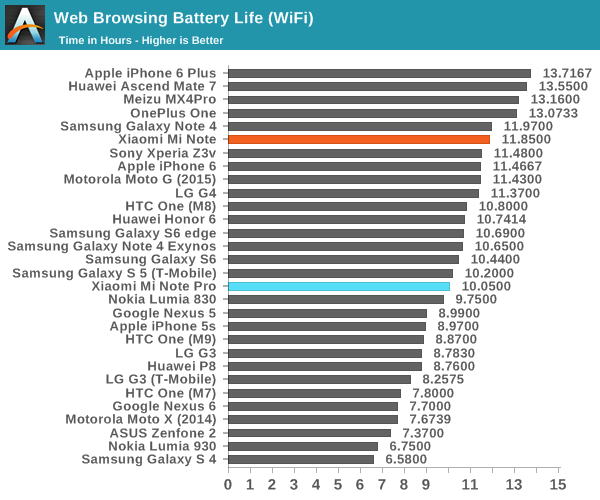
Moving past our display power testing, the web browsing test is the lightest test in our suite that includes both RF power and some CPU workload. Here, we see some pretty interesting result. Assuming both devices have nominal battery capacity the Mi Note averages around 1W in this test. The Mi Note Pro averages about 1.2W, or roughly 200 mW higher throughout the test. Both displays are in a command mode to enable panel self-refresh and power appears to be roughly equivalent. While the M9 had a number of confounding factors, with the Mi Note Pro it is increasingly evident that the Snapdragon 810 causes a noticeable regression in battery life, even in very light CPU workloads where the work done per time is identical. At any rate, both perform respectably in this test, even if the Mi Note Pro does fall a bit short relative to other phablets.
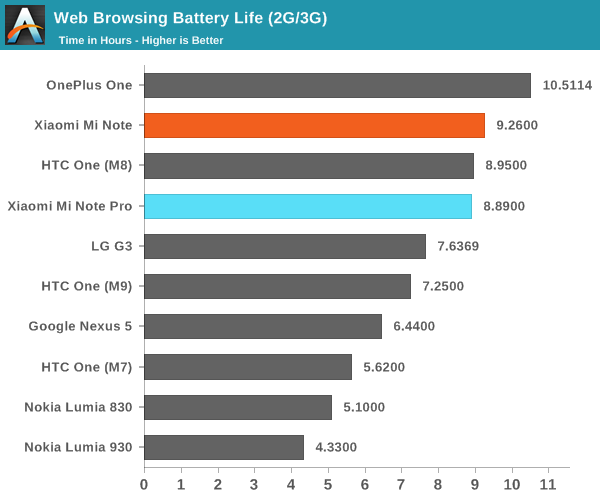
Unfortunately, with the Mi Note devices we don’t have the ability to do our standard LTE comparisons, but I’ve run the same test on AT&T’s WCDMA network which should provide a decent modem comparison as well. Interestingly, here it seems pretty clear that the gap that appears in WiFi browsing almost disappears when running on HSPA+. Given that 3G strongly stresses modem performance, it does appear that the modem in the Snapdragon 810 brings power efficiency improvements over previous generations. However, it looks like it isn't quite enough to completely compensate for the difference in CPU efficiency.
Mi Note / Mi Note Pro
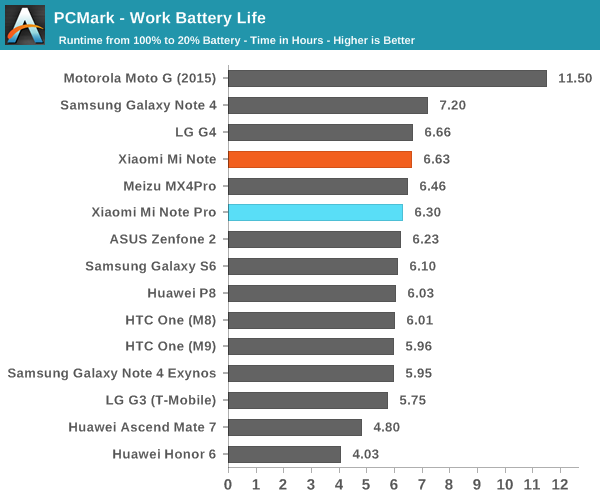
Moving on to PCMark, our balanced CPU/display battery life test, we see some interesting results as well. If we look purely at power, one would probably assume that the Snapdragon 810 is losing here, but once you consider average performance throughout the test, the Mi Note appears to do worse overall. However, due to Xiaomi’s rather conservative governor on the Mi Note and the different Android versions it’s hard to draw any conclusions from this test as PCMark results are strongly dependent upon Android version. The one device that we have on-hand with Snapdragon 805/801 and Lollipop 5.x is the Galaxy Note 4, which clearly exceeds the Mi Note Pro in both performance and runtime even after compensating for the difference in battery size. I didn't realize this until writing up the review, but PCMark is probably the best demonstration of the battery life improvements that come with Lollipop and ART as this is one of our benchmarks that strongly depends upon VM performance.
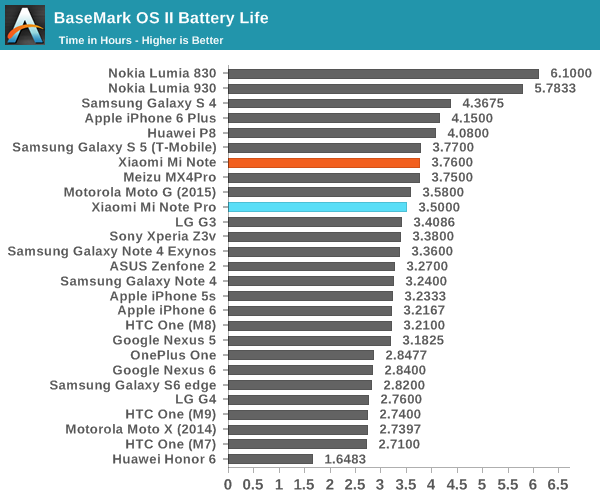
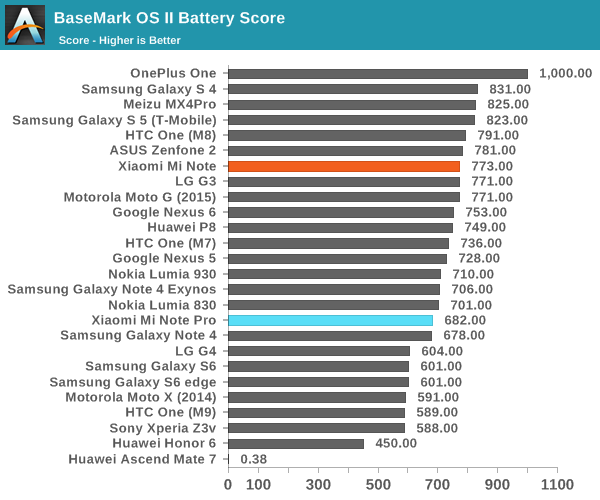
At the more extreme end of the segment, Basemark OS II is a test designed to really place significant pressure on the CPU. In this test, we once again see that the Mi Note lasts significantly longer than the Mi Note Pro. If you’re like me, you would probably assume that the Mi Note does so because it doesn’t deliver as much performance, but looking at the battery score shows that the Mi Note Pro consistently sustains higher load over the duration of the test. Xiaomi has done a great job of keeping thermals under control with the Mi Note Pro, but despite this it’s clear that the SoC is just consuming a lot of power here.
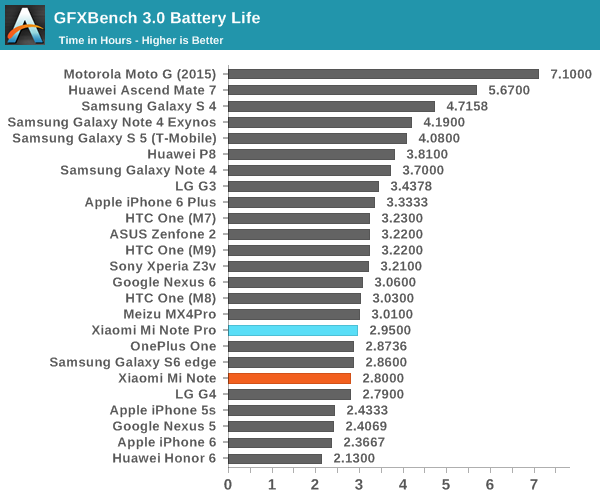
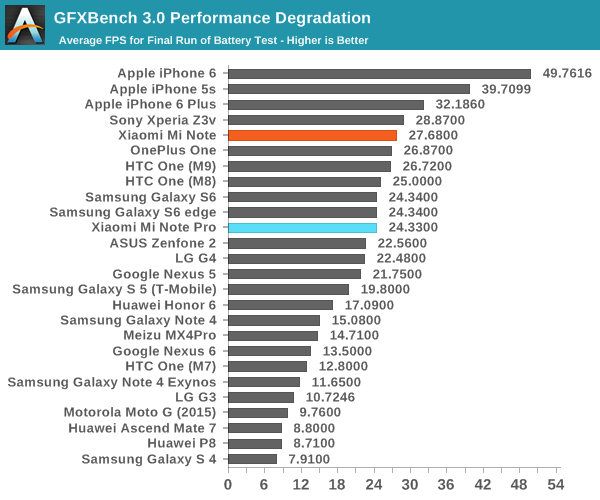
In GFXBench, our GPU-bound rundown test we actually see some interesting results. The Mi Note lasts slightly less time than the Mi Note Pro (2.75hrs to 2.92 hrs), but with a higher frame rate on the Mi Note using the Adreno 330 rather than the Adreno 430. This comes apparent when you remember that the Mi Note is only rendering at 1920x1080, compared to the Mi Note Pro at 2560x1440. The Mi Note also manages to basically last the entire test run without any noticeable throttling. The Mi Note Pro does have noticeable throttling relative to the start of the test, but even in the throttled state it beats out the Mi Note despite the higher render resolution. So the Mi Note doesn't throttle and has the higher frame rate by ~15%, but the Mi Note Pro lasts longer and does so at a higher resolution.
Overall, the battery life of the Mi Note is acceptable and comparable to most phablets on the market, while the Mi Note Pro falls slightly under par. I doubt most users will really notice a big difference here, but both devices should get most people through a full day of use without any kind of range anxiety. Given that the SoC is basically the single biggest difference between the two devices when it comes to power consumption, it’s definitely concerning how the Mi Note Pro appears to regress relative to the Mi Note in any kind of CPU-bound workload when the Snapdragon 810 is fabricated on a more advanced 20nm process.
Charge Time
Battery life is usually the primary way by which mobility is determined, but in a number of scenarios charge time becomes critical. The usual cases where this might happen include forgetting to plug in your phone before going to bed and long distance flights. I’m sure there are a number of people out there that will point to most of these cases as a good reason for removable batteries, but based on discussions with OEMs it’s clear that most people don’t carry a second battery around on a regular basis. As a result, the speed with which a smartphone can charge is relevant in these scenarios. In the case of the Mi Note, the charger is limited to a rather standard 5V, but the Mi Note Pro supports QC 2.0 fast charging at 9V. The included charger is limited to 1.3A though, so much of the charge speed improvements will come from less power loss over the charger cable rather than higher wattage. In order to test charge time, we measure the time it takes for a phone to charge with its included charger until the phone indicates 100% either through an LED or by measuring power draw at the wall.
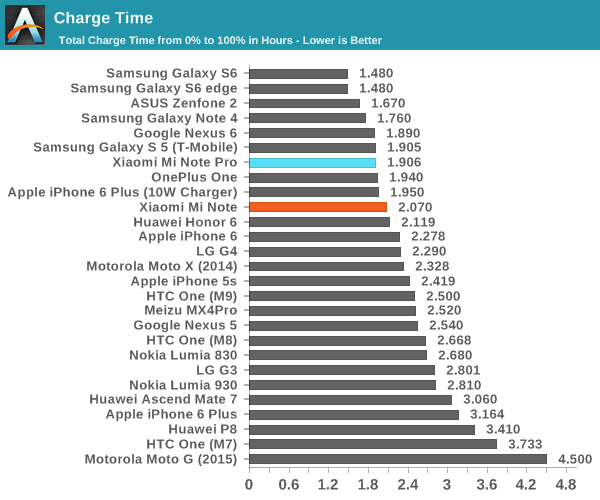
As we can see, the benefit of fast-charging with the Mi Note Pro’s included charger is relatively small but definitely noticeable. It actually ends up about as fast as the OnePlus One with a 5V, 2.1A charger which suggests that this move was mostly done in order to improve energy efficiency and mildly improve charge rate while balancing battery longevity. It's worth noting that even though the Mi Note Pro has the same charge time under our testing, looking at the graph it's clear that the Mi Note Pro will charge faster in the linear region before slowing down to achieve the previously mentioned improved battery longevity.
The Mi Note performs as one would expect from a standard 5V charger, and doesn't support fast charge judging by its behavior on the charger. Overall, both phablets do about as well as one would expect here. Looking at the mobility equation holistically, the Mi Note is better than the Mi Note Pro, and as a result the conclusions for both are noticeably different. I would say that the Mi Note is on par with other phablets launched today, but the Mi Note Pro is below average due to the Snapdragon 810 in this device, v2.1 or not. It's unfortunate that this is the case, but I suspect Xiaomi has been backed into a corner when it comes to SoC choice here.


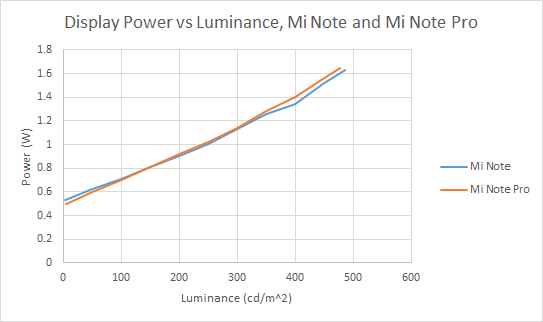
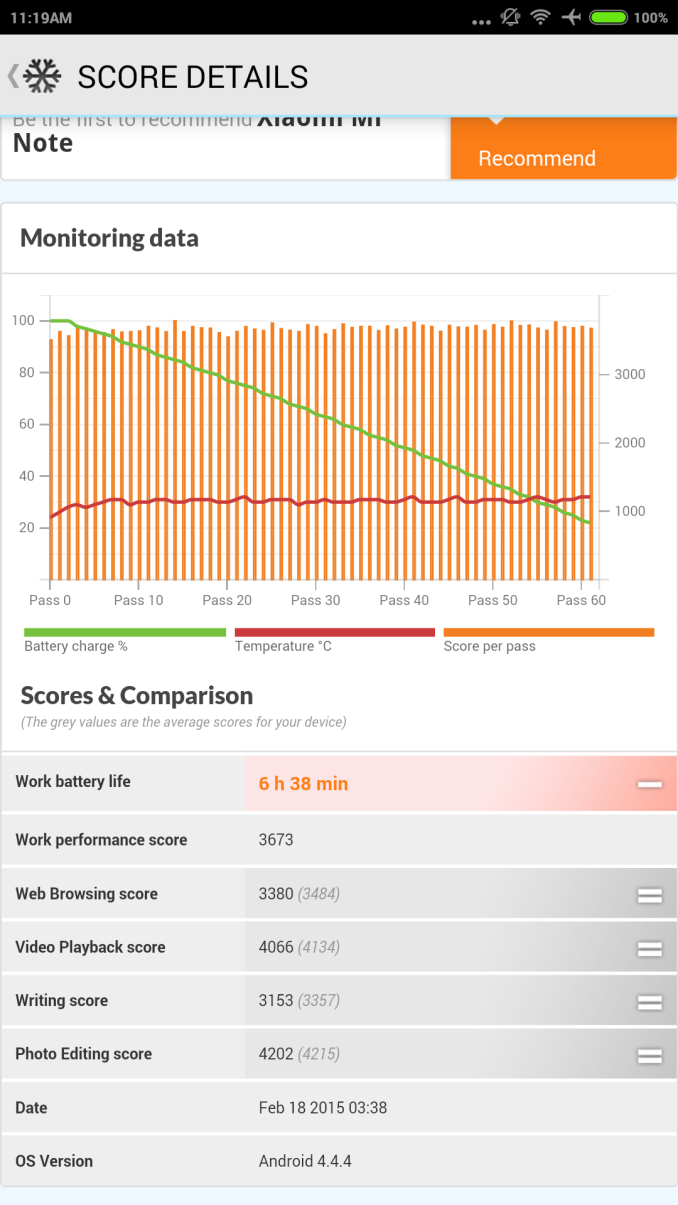

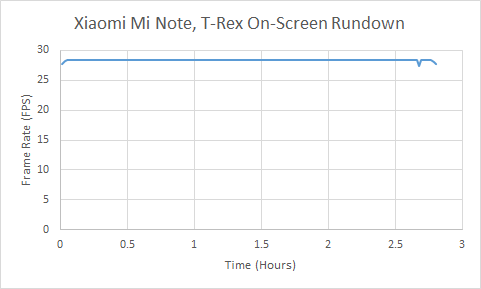
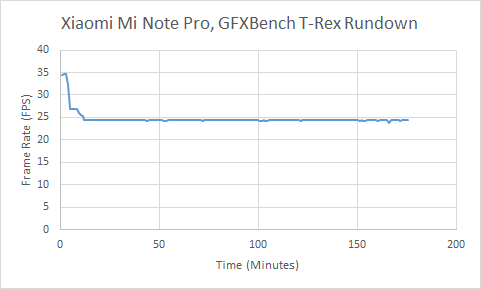
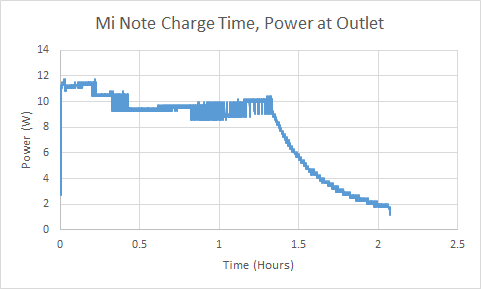
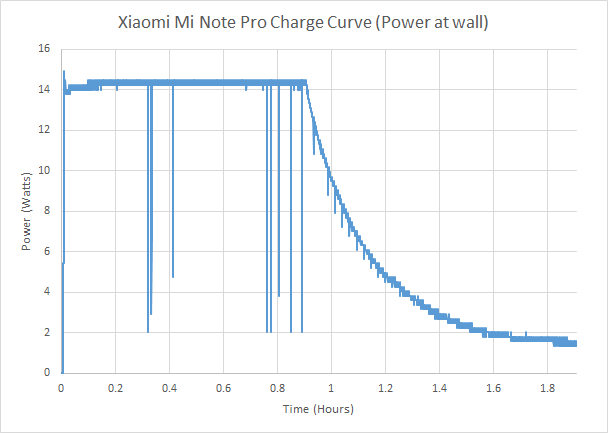








94 Comments
View All Comments
valinor89 - Friday, September 11, 2015 - link
Xiamomi is about to start trials with some products in the Us and other countries. You could end up having acces to this phone or its successor before long...Or do like the people who bought those korean screens early on and import.
I live in Europe and most of the products reviewed here are not directly avaiable to me, even less at the same relative price, 1€=1$ over here, but I still like to read about new product tendencies, at the minimun it lets me evaluate the products I can get in another light.
menting - Friday, September 11, 2015 - link
How are phones any ground breaking nowadays? There have been 0 phones in the past few years that are groundbreaking, with maybe the exception of the S6 Edge with the curved screen. And if it's fair to whine about something you can't use, then 1) Verizon/Sprint customers will be whining more than 50% of the time here, and 2) Who said you can't use it? Does the lack of LTE make it unusable? BS.Yaru - Sunday, October 4, 2015 - link
You don't have to care but I very very much do. Not all of their products are only applicable to the US, some of them apply to other countries as well.Also, you can buy a Xiaomi phone from the US. Much like I can buy US phones from here. The iPhone 6+ I'm using to type this comes directly from the US (a T-Mobile to be exact). Just because Xiaomi doesn't sell it directly doesn't mean you can't buy it.
lilmoe - Friday, September 11, 2015 - link
That's the worst thing one could ever do really. You should buy a product that has proper support in your country. Good luck finding parts or repairing the device. And good luck if you get a lemon.mforce - Friday, September 11, 2015 - link
Actually I bought an LG Optimus G made for Korea ( F180L ) which I've flashed with the ROM for E975 but keeping the modem part of the F180L .... I have all the 2G and 3G bands working perfectly here in the EU and the phone has been doign well for 2 years now.It is true that it's a risk you're going to make when buying without a local warranty but the seller might still honor your warranty if you send it back. Also yes you need to carefull look at the supported bands but some might just work out fine and be what you need in your country too.
Xiaomi does make phones which have all the right bands for the EU ( including LTE ) so I'm OK with reading reviews about Xiaomi phones such as this.... this isn't a US only website you know. Maybe folks from China read it too for instance ... Also many Xiaomi phones are available in India where they speak EN so ...
DigitalFreak - Friday, September 11, 2015 - link
You just don't get it. No-one said they shouldn't review non-US phones. Just put a blurb in the beginning saying it doesn't support US bands. Why is that one simple thing so hard for people to comprehend?Pissedoffyouth - Friday, September 11, 2015 - link
>I'd rather not waste my time reading a review of something that's only available in Asia/Europe.Why not? I'm a tech head, I'm happy to read reviews of droids only available on Verizon even though I'm in Europe because its great to see what competition ithere is.
menting - Friday, September 11, 2015 - link
talk about being self-centered! So they'll have to say if it's going to be on Sprint and/or Verizon too I suppose?DigitalFreak - Friday, September 11, 2015 - link
Yeah, because I'm the only person who reads through a review only to find out they won't be able to use the device.BMNify - Friday, September 11, 2015 - link
Anandtech is an International website with only 40% of the readership coming from USA and Xiaomi already caters to the largest smartphones markets that is China, India, Brazil, Taiwan, Singapore, Malaysia and Philippines. So, your redneck 'Murican pride is misplaced here.